Dollar eyes weekly gain; sterling wobbles on lower rate bets, bleak outlook

SINGAPORE (Reuters) - The dollar looked set to post its best week in over a month on Friday on expectations that US rates could peak higher, while sterling was on the ropes as investors revised their rate projections after a shift in tone from the Bank of England.
The greenback surged overnight, knocking the euro and the Aussie to their lowest in nearly two weeks. Sterling was further pressured by a sobering assessment of Britain's growth outlook and a message from the BoE that rates may go up by less than markets have priced in.
The dollar later reversed some of those gains in Asia trade on Friday, with the euro up 0.23% at $0.9772 and the kiwi gaining 0.51% to $0.5805.
Against a basket of currencies, the US dollar index fell 0.23% to 112.71, away from a near two-week peak of 113.15 hit overnight. Nonetheless, it was on track for a weekly gain of nearly 2% -- its largest since September.
Fed rate futures now point to a terminal rate of about 5.15% by mid-2023, after the Federal Reserve raised interest rates by three-quarters of a percentage point this week.
While investors initially cheered a signal that the central bank may be nearing an inflection point in its aggressive monetary policy tightening campaign, Fed Chair Jerome Powell was quick to dampen hopes of a potential pivot, adding that it was "very premature" to discuss when the Fed might pause its increases.
"Overall, the dollar has economic and central bank relativities on its side, and for now, it's sort of the realisation that (a) pivot is not really coming in, it's just a downshift in terms of gears," said Rodrigo Catril, a currency strategist at National Australia Bank (NAB).
Markets now turn their attention to key US jobs data due later on Friday, with economists polled by Reuters expecting nonfarm payrolls to have increased by 200,000 jobs in October.
Sterling was up 0.50% at $1.1215, clawing back some of its losses from a 2% slide overnight.
It was headed for a weekly loss of more than 3%, the largest since September's market turmoil triggered by an economic plan that alarmed investors.
While the BoE raised interest rates by the most since 1989 on Thursday, it warned investors that the risk of Britain's longest recession in at least a century means borrowing costs are likely to rise less than they expect.
"Sterling is getting a dose of the reality of the economy. That the Bank of England has to make - surely to the fiscal side - tough choices," said NAB's Catril.
"It's been sort of coming for some time that the Bank of England is a reluctant hiker ... in the current environment. But certainly, those inflation numbers are still way too high."
Elsewhere, the Japanese yen last bought 148.14. Moves to the currency have been relatively more subdued on concerns about further intervention from Japanese authorities.
Finance Minister Shunichi Suzuki said that Japan's currency interventions have been stealth operations in order to maximise the effects of its forays into the market, with the government having spent a record $43 billion supporting the yen last month.
The Aussie was up 0.68% at $0.6331.
The Reserve Bank of Australia on Friday downgraded the outlook for economic growth, warning that more rate hikes will be necessary to bring down sky-high inflation even as it strives to avoid an outright recession.







